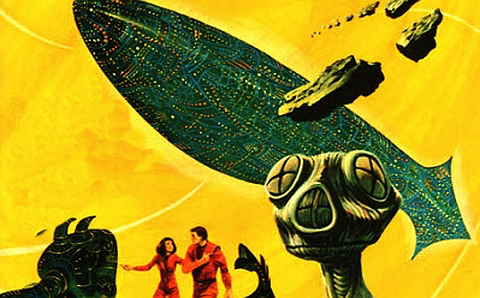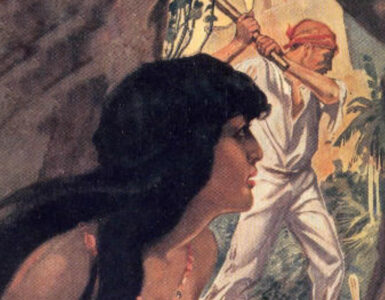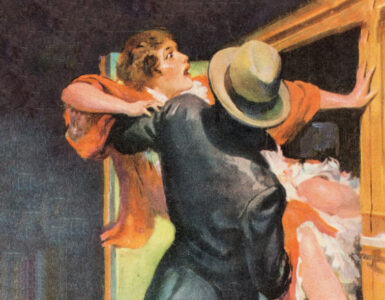The FANTASTIC Elinor Mavor & the TSR Years
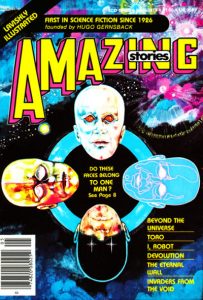 When Sol Cohen passed full ownership of AMAZING STORIES and FANTASTIC to his partner, Arthur Bernhard, the editorial offices of Ultimate Publishing moved to Bernhard’s home base of Scottsdale, Arizona. Ted White chose not to continue as editor, mostly because of the lack of infusion of money into the magazines, and he returned to their authors all of the manuscripts he had accumulated for upcoming issues.
When Sol Cohen passed full ownership of AMAZING STORIES and FANTASTIC to his partner, Arthur Bernhard, the editorial offices of Ultimate Publishing moved to Bernhard’s home base of Scottsdale, Arizona. Ted White chose not to continue as editor, mostly because of the lack of infusion of money into the magazines, and he returned to their authors all of the manuscripts he had accumulated for upcoming issues.
Bernhard was left with no new material, and no editor. He brought in the mother-and-son team of Scott and Elinor Mavor, who ran a graphic design studio in Scottsdale. They became the editorial and production staff. Bernhard felt that a woman’s name as editor might not be well accepted by the readers, and he also wanted to boost the number of names on the magazine’s masthead, so he invented the persona of Omar Gohagen to take over the editorial reins. Considering that AMAZING had enjoyed a golden age under Cele Goldsmith, this deception was not entirely logical thinking on Bernhard’s part. And it meant that the name of AMAZING‘s eleventh editor (twelfth, if you include Hamling) was a fabrication, something that did not help to improve the magazine’s image.
Admittedly Elinor Mavor started with a significant handicap, seeking to put out a magazine in a matter of weeks with no new material. But at the outset there was no evidence that any effort was going into the magazines. The April 1979 issue of FANTASTIC and the May 1979 issue of AMAZING were dreadful. They looked cheap, contained only passable reprints and a couple of amateurish new stories, and gave every indication that the magazines were reverting to the drabness of the reprint issues of the late 1960s. It seemed as if all that White had achieved in the 1970s had been destroyed in one fell swoop. There was also created the impression that the Mavors did not understand their market. They started a reader-participation graphic story called “Mecano Sapiens,” which makes me shudder to even think of it. This kind of feature had cropped up occasionally in sf magazines over the years, and never had worked.
I recall receiving these issues with despair and writing a hasty alarm-bells letter to “Omar Gohagen,” pleading that something be done. I received a pleasant postcard from Omar, acknowledging my views but remarking that most letters the magazine was receiving showed that readers were pleased with what was happening. And indeed, so it seemed from the letters appearing in the letter column. Mind you, I was a little concerned about what some of them were saying:
“The thing about the new AMAZING that strikes me most is the look,” wrote one reader from Sweden in the February 1980 issue. “It’s beautiful!”
Well, beauty is in the eye of the beholder, but that opinion amazes me. In that same issue another reader wrote:
“I just picked up a copy of the August AMAZING and was overjoyed. ‘The Council of the Drones’ was one of the best SF stories I have read in years! Yours is the best SF magazine in the business.”
I wonder what else this fan was reading. “Council of the Drones” by W. K. Sonnemann, was a reprint from the October 1936 issue. AMAZING might have been attracting a readership, but it didn’t seem to be one totally au fait with science fiction or its magazines.
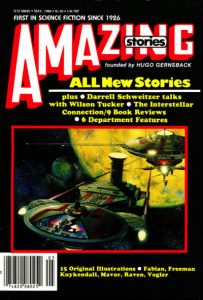 The evidence of circulation figures might be a better measure of the reception of the magazine. Its newsstand sales dropped from almost 21,000 in White’s last year to around 16,400 in Mavor’s first. While some of this decline may be attributed to a lack of promotion of the magazine and the chronic distribution problems, it must also be true that the magazine just failed to make an impact on the stands, “beautiful” or otherwise.
The evidence of circulation figures might be a better measure of the reception of the magazine. Its newsstand sales dropped from almost 21,000 in White’s last year to around 16,400 in Mavor’s first. While some of this decline may be attributed to a lack of promotion of the magazine and the chronic distribution problems, it must also be true that the magazine just failed to make an impact on the stands, “beautiful” or otherwise.
Nevertheless, I was delighted to find that over the next few issues, both magazines improved. It became clear that Elinor Mavor was making an effort to develop them. She introduced some attractive illustrative features, such as Stephen and Chip Fabian’s graphic story “Daemon” in FANTASTIC, and brought in new artists, of whom the most stunning was Gary Freeman. In fact, within a year, with the artwork of Freeman, Fabian, and (later) Alicia Austin, AMAZING was indeed verging on “beautiful.” The fiction was also looking up. Mavor disposed of the reprints as quickly as possible, although retaining a classic reprint department in which authors provided new introductions to their old stories.
Mavor introduced some talented new writers. It would be no surprise that, having started with an empty inventory, she might have selected some poor early stories, just to get an issue together; and though it might be uncharitable to say so, I think most of the new authors discovered in the first few issues appeared because of these fortuitous circumstances. But among the rocks was the rare glitter. The August 1979 AMAZING carried “The Inevitable Conclusion,” the first published story by Michael Kube-McDowell. He became a regular contributor to the magazine over the next few years before establishing himself in the wider field. His “Antithesis” from the February 1980 AMAZING was highly regarded. It’s a clever piece of scientific double-speak in which a student finds a loophole in Einstein’s theories. The November 1979 AMAZING introduced Wayne Wightman, who would become closely linked with the magazine for some time thereafter. Wightman was a powerful writer and satirist with challenging new ideas. His stories began to set a standard for freshness in the magazine.
Gradually some of the bigger names returned to AMAZING, writers whose individual approaches to fiction suited the flexible policy of the magazine. Writers such as David R. Bunch, Barry Malzberg, Marvin Kaye, Darrell Schweitzer, Garry Kilworth, and Greg Benford were joined by new writers Brad Linaweaver, J. Ray Dettling, and Lawrence Connolly. None of these authors gave AMAZING any clear direction, but they gave the magazine a vitality that it had not seen since the early 1970s.
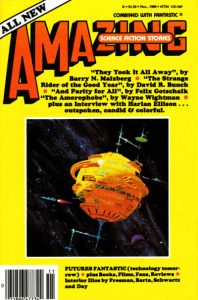 Then a bomb was dropped. Seeking to cut costs, Bernhard decided to merge FANTASTIC with AMAZING STORIES. The last issue of FANTASTIC appeared in October 1980. That magazine had been published for 208 issues over twenty-eight years. If you include its pulp godparent, FANTASTIC ADVENTURES, it had survived for 337 issues. And now, for the first time in forty-one years, AMAZING had no sister publication.
Then a bomb was dropped. Seeking to cut costs, Bernhard decided to merge FANTASTIC with AMAZING STORIES. The last issue of FANTASTIC appeared in October 1980. That magazine had been published for 208 issues over twenty-eight years. If you include its pulp godparent, FANTASTIC ADVENTURES, it had survived for 337 issues. And now, for the first time in forty-one years, AMAZING had no sister publication.
The first combined issue was dated November 1980. The magazine shifted from a quarterly schedule to bimonthly — though this meant only six issues a year compared to eight of the two magazines — and increased slightly in height, adding half an inch to its digest dimensions, presumably so that it would poke above the other magazines on the newsstand rack (a gimmick that only lasted a few issues). With this issue Elinor Mavor was revealed as the true editor, and Omar Gohagen was cast into the pit of oblivion. At last Mavor was receiving personal credit for her hard work.
There was one other change, the logic of which still escapes me. The full title of the magazine, which had reverted to AMAZING STORIES after Ted White left, became AMAZING SCIENCE FICTION STORIES again, even though it also boasted “combined with FANTASTIC.” Why the magazine should choose to promote itself as “science fiction” when, for the first time, it was publishing a fair quota of fantasy remains a mystery. This development underlies a more significant matter, which I shall return to later.
The new combined AMAZING/FANTASTIC had a buzz about it that was thrilling. It was attracting exciting writers — Harlan Ellison, Alan Ryan, Hank Stine, Somtow Sucharitkul, Lisa Tuttle, George R. R. Martin, Jessica Amanda Salmonson, Roger Zelazny, Orson Scott Card, Richard A. Lupoff — all of whom were not afraid to try something new and different. By 1982 the stories in the magazine were once more turning up on the Hugo and Nebula Award ballots. George R. R. Martin’s sf-chess story “Unsound Variations” (January 1982) came in third in the Hugo voting. Brad Linaweaver’s “Moon of Ice” (March 1982), a new twist on the Nazis-won-the-War theme, was likewise highly regarded. No less a luminary than Andre Norton praised the story and urged Linaweaver to expand it into a novel. Ernest Hogan debuted with a controversial story, “The Rape of Things to Come” (March 1982), which elicited much reader reaction to its projection of commercialized rape. There was also John Steakley’s consideration of courage and human dignity in an alien-occupied world, “The Bluenose Limit” (March 1981), which Barry Malzberg commended as “a stunner.”
The fiction, the artwork, and the variety of nonfiction features (from interviews to story analyses) gave a good balance to the magazine and an indication of an editor who was thinking and experimenting. In three years with the magazine, from a standing start, Elinor Mavor had worked miracles.
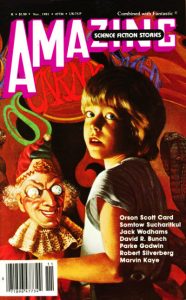 But as 1982 dawned, Arthur Bernhard, now seventy years old, gave notice that he wanted to sell the magazine. Although he had invested no money in promoting the publication, he cared for the venerable old title and wanted it to have a good home. Alas, an experiment in cost-cutting had proved a failure. In 1981 Bernhard had reduced the print run of AMAZING from around 66,000 to 53,000, yet the magazine maintained newsstand sales of 17,000. Thus, Bernhard saved on production costs without suffering a decrease in income. But the next time he tried the same tactic, cutting the number printed to 43,000, there was a savage drop in newsstand sales down to 10,600. AMAZING‘s survival was on the borderline.
But as 1982 dawned, Arthur Bernhard, now seventy years old, gave notice that he wanted to sell the magazine. Although he had invested no money in promoting the publication, he cared for the venerable old title and wanted it to have a good home. Alas, an experiment in cost-cutting had proved a failure. In 1981 Bernhard had reduced the print run of AMAZING from around 66,000 to 53,000, yet the magazine maintained newsstand sales of 17,000. Thus, Bernhard saved on production costs without suffering a decrease in income. But the next time he tried the same tactic, cutting the number printed to 43,000, there was a savage drop in newsstand sales down to 10,600. AMAZING‘s survival was on the borderline.
By February 1982 Bernhard was in negotiation with a number of potential buyers — one of whom, Jonathan Post, even went so far as to advertise for submissions. The successful purchaser, though, was TSR Hobbies, Inc., the company that had established itself as the producer of the DUNGEONS & DRAGONS® game. The trail that led to TSR began with George Scithers, who had recently stepped down as editor of the successful ISAAC ASIMOV’S SCIENCE FICTION MAGAZINE. Bernhard offered the magazine for sale to Scithers who, although he didn’t have the capital to go through with the purchase himself, told a friend at TSR about the availability of the magazine. During the first week of March 1982, the sale was agreed upon and Scithers was hired as the new editor.
Elinor Mavor’s last issue of AMAZING was dated September 1982. She bowed out gracefully and poignantly, remarking how much she loved the magazine. That sentiment showed. Her style and approach remained evident in the magazine for some time to come, and her love and devotion had given the magazine hope if not certainty.
TSR was already producing a successful gaming periodical, DRAGON® MAGAZINE, which carried a piece of fantasy fiction in each issue. Purchasing AMAZING SCIENCE FICTION STORIES gave the company an opportunity to expand its publishing line in a new direction.
Scithers operated out of Philadelphia, supported by a team of first readers and assistants (known colloquially as “the Zoo”) which at the start included John Ashmead, Darrell Schweitzer, John Sevcik, and Meg Phillips. Thus, AMAZING was being edited long distance (the same circumstance that had ultimately led to Scithers’s departure from ASIMOV’S), while production personnel were based at TSR’s offices in Lake Geneva, Wisconsin.
Although Scithers was not nominally involved with production, he was in charge of the magazine’s design. In this respect, the first noticeable feature of his version of the magazine was how much it resembled ASIMOV’S. The similarities could be seen in the design of the contents page, the move to single-column text instead of the traditional two columns, and the cover art. In fact, Scithers acknowledges that the design format form ASIMOV’S as well as his incarnation of AMAZING™ SCIENCE FICTION STORIES was copied from a format that had been devised by Fred Dannay and first used for ELLERY QUEEN’S MYSTERY MAGAZINE — which was, like ASIMOV’S, a Davis publication.
(Editor’s note: The above change in the designation of the magazine’s name came about immediately after TSR Hobbies, Inc., purchased the title, whereupon the company filed for the right to ownership of the title “Amazing” as a trademark. Beginning with the September 1984 issue, at which time the trademark became registered, the magazine was known as AMAZING® SCIENCE FICTION STORIES.)
Less surprising was the editorial similarity between the two magazines. Scithers brought his customary urbane style to bear upon the editorial and nonfiction features. He also purchased material from many of the same authors he had encouraged at ASIMOV’S, and this was most evident in the cases of Somtow Sucharitkul and Avram Davidson. Both of these authors brought with them story series that they had started in the pages of ASIMOV’S, Sucharitkul with his stories about Aquila, set in an amusing alternate reality where the Romans had conquered North America, and Davidson with his ever-indefinable “Adventures in Unhistory.”
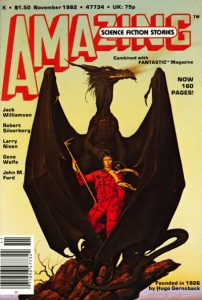 What was surprising was that the magazine retained its digest format. There was some speculation among fans of the magazine at the time that TSR might expand AMAZING STORIES into the slick format, matching the presentation of DRAGON® MAGAZINE. That this did not happen was seen as an indication that perhaps not as much money was going to be injected into the magazine as its followers had hoped. But TSR did put out a considerable amount of cash in the early days in paying off all the outstanding manuscript contracts (originally written as “pay on publication” agreements), raising the rates for new material to match what was being paid by ASIMOV’S and ANALOG, and commissioning a cover from Michael Whelan for the first all-Scithers issue, November 1982. (Subsequent issues were a mixture of Mavor-bought and Scithers-bought material, until all of the old inventory had been used up.)
What was surprising was that the magazine retained its digest format. There was some speculation among fans of the magazine at the time that TSR might expand AMAZING STORIES into the slick format, matching the presentation of DRAGON® MAGAZINE. That this did not happen was seen as an indication that perhaps not as much money was going to be injected into the magazine as its followers had hoped. But TSR did put out a considerable amount of cash in the early days in paying off all the outstanding manuscript contracts (originally written as “pay on publication” agreements), raising the rates for new material to match what was being paid by ASIMOV’S and ANALOG, and commissioning a cover from Michael Whelan for the first all-Scithers issue, November 1982. (Subsequent issues were a mixture of Mavor-bought and Scithers-bought material, until all of the old inventory had been used up.)
The Scithers-era magazine was ever readable. It had lost some of that excitement that had started to bubble in Mavor’s issues, but it could always be relied upon for solid, dependable fiction. A particularly notable issue was that for November 1983. Its attractive George Barr cover illustrated “Eszterhazy and the Autogóndola-Invention,” one of a series of delightfully unconventional stories set in a world-that-really-should-have-been and featuring the exploits of Dr. Eszterhazy as recounted by Avram Davidson. In the same issue was “Homefaring” by Robert Silverberg, where, in the first time-travel experiment, a man’s mind is projected millions of years into the future. He finds himself coming to terms with the lobsterlike creatures whose society becomes reality to him. Both of these stories were nominated for Nebula Awards. Also in that issue was “Cyberpunk,” a first sale by Bruce Bethke about near-future youths in a world dominated by technology — the story that ultimately gave its title to a whole sub-movement in science fiction.
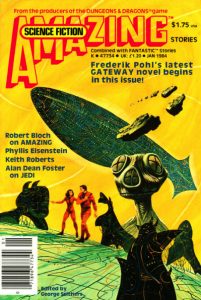 The potential for wide appeal in AMAZING STORIES was evident from the attention given to William Wu’s story, “Wong’s Lost and Found Emporium,” from the May 1983 issue. This piece was nominated not only for the Hugo and Nebula Awards, but also for the World Fantasy Award. It was also converted into a screenplay and produced as an episode of THE NEW TWILIGHT ZONE television show. Two other stories by Wu set in the Emporium have also appeared in AMAZING STORIES, most recently “Missing Person” in the April 1992 issue.
The potential for wide appeal in AMAZING STORIES was evident from the attention given to William Wu’s story, “Wong’s Lost and Found Emporium,” from the May 1983 issue. This piece was nominated not only for the Hugo and Nebula Awards, but also for the World Fantasy Award. It was also converted into a screenplay and produced as an episode of THE NEW TWILIGHT ZONE television show. Two other stories by Wu set in the Emporium have also appeared in AMAZING STORIES, most recently “Missing Person” in the April 1992 issue.
The magazine was also attracting writers, both new and established. Not only were there stories by Frederik Pohl, Damon Knight, Keith Roberts, Tanith Lee, and Gardner Dozois, but also by developing writers Michael Swanwick, Paul J. McAuley, and Richard Grant. A surprise but welcome visitor was Andrew M. Greeley. This somewhat unorthodox Catholic priest, who had written such best-sellers as THE CARDINAL SINS and THY BROTHER’S WIFE, had only once before stepped into the world of legend, with THE MAGIC CUP (1979), an Irish version of the tradition of the Holy Grail. Now, for the first time, Greeley extended his talents to short fantasy fiction, starting with “The Great Secret” (September 1983), wherein a lord in a timeless world strives to discover the secret of the cosmos without realizing, as love takes control over him, that perhaps he had already found it.
One golden opportunity presented itself in 1984. Universal Studios leased the title of “Amazing Stories” from TSR to use as the name of a science-fiction anthology television series to be produced by Steven Spielberg (although the Spielberg connection was not made public at the time when Universal contacted TSR). The series, launched in the fall of 1985, featured mostly original material directed by many leading names. Yet, despite being able to proclaim “Now a TV series . . .” on the cover, the magazine gained no advantage from this series. Perhaps its only effect was to see the magazine revert to its original title, AMAZING® STORIES, with the March 1986 issue.
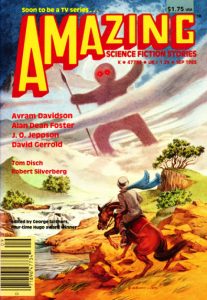 Regardless of the quality and entertainment value in AMAZING STORIES, its newsstand sales refused to rise appreciably. At the beginning of Scithers’s tenure, newsstand circulation was at around the 11,000 mark. That was only a little behind most of the other digest-sized fiction magazines; and after a time, sales rose to the point where AMAZING STORIES was outselling ASIMOV’S on the newsstand. However, it must be noted that this period was not a good time for any fiction magazine on the newsstands — a situation that has persisted to the present day.
Regardless of the quality and entertainment value in AMAZING STORIES, its newsstand sales refused to rise appreciably. At the beginning of Scithers’s tenure, newsstand circulation was at around the 11,000 mark. That was only a little behind most of the other digest-sized fiction magazines; and after a time, sales rose to the point where AMAZING STORIES was outselling ASIMOV’S on the newsstand. However, it must be noted that this period was not a good time for any fiction magazine on the newsstands — a situation that has persisted to the present day.
The main reason that the other science-fiction magazines remained far ahead of AMAZING STORIES in overall circulation was that each of them had a substantial subscription base of tens of thousands, whereas, at the time that Scithers took over, subscribers to AMAZING STORIES numbered less than a thousand. During Scithers’s editorship, subscriptions almost tripled. This did not come about through any promotion on TSR’s part (though some readers may have leaked over from DRAGON® MAGAZINE), but was probably caused by the devoted core of active science fiction fans (as distinct from passive readers) who returned to AMAZING STORIES in support of Scithers.
Nevertheless, despite this encouraging increase, the existence of the magazine was always on a knife-edge, and further rationalization took place. It was seen as no longer practical for Scithers to edit the magazine long distance, and in February 1986 he departed. He would soon establish himself as editor of the newly revived WEIRD TALES, thus giving him the unique distinction of having edited both the first fantasy magazine and the first science-fiction magazine.
Scithers’s editorial duties were taken over by Patrick L. Price, who was already experienced with the magazine after having served as an assistant editor (based in Lake Geneva) since the September 1983 issue. There were some superficial changes, including a revamped contents page of which many readers approved but which I found confusing. And there were more solid changes: Martin H. Greenberg, renowned multi-anthologist, came on as editorial consultant, and a new art feature, “On Exhibit,” was established.
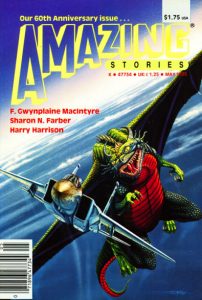 In the all-important area of fiction, Price wrote in his inaugural issue (September 1986) that he wanted the magazine to return to its origins: “. . . the primary focus of our story selections will be in the areas of hard and speculative science tales, militaristic science fiction, and space fantasy or opera.”
In the all-important area of fiction, Price wrote in his inaugural issue (September 1986) that he wanted the magazine to return to its origins: “. . . the primary focus of our story selections will be in the areas of hard and speculative science tales, militaristic science fiction, and space fantasy or opera.”
This brings us back to the issue that had surfaced earlier, and that is the extent to which fantasy had begun to dominate AMAZING STORIES. It is a quite fundamental issue. When Hugo Gernsback launched AMAZING STORIES, he was most emphatic in his statement that the magazine would carry stories based on experimental science. It would not feature anything that might not be possible some day through scientific achievement. Any other stories he regarded as “fairy tales.”
Although the science in many of the stories through the years may have been questionable, the magazine remained more or less true to this vision until the moment it was merged with FANTASTIC. In trying to retain the balance of the two magazines, fantasy became a regular feature of AMAZING and, at that point, it ceased to be AMAZING STORIES. It had, in real terms, become FANTASTIC. That latter publication had always had a wide base to its contents, and though its title suggested it was a fantasy magazine, it frequently carried science fiction, usually of a surreal or avant garde nature.
I had noticed this phenomenon at the time it occurred. Whereas my heart sank at the thought that we had lost FANTASTIC, a magazine I had always enjoyed, my mind soon told me that the magazine I was reading was no different from FANTASTIC.
It was a dilemma from which there was no escape. Despite Price’s wish to promote more science fiction in AMAZING STORIES, that turn of events never really came about. To be sure, hard sf stories did appear — Robert Silverberg’s “The Iron Star” (January 1988), John Barnes’s war story “Delicate Stuff” (July 1988), Robert Sawyer’s space adventure “Golden Fleece” (September 1988), and Greg Benford’s superb Venerian expedition “Alphas” (March 1989) — but the bulk of the fiction, and the general overall feel of the magazine, was fantastic. Much of the best fiction being written was not hard sf, which has become a rarity. Most scientific or speculative sf has merged with the fantastic, creating a form of mainstream fantasy.
AMAZING STORIES was not alone in this situation. Only ANALOG remained the one true science-fiction magazine. ASIMOV’S carried a balance of fantasy and sf, as did, most obviously, THE MAGAZINE OF FANTASY & SCIENCE FICTION. In fact, based on fiction alone, it was difficult to tell these magazines apart. ASIMOV’S had higher quality, as a rule, but both AMAZING STORIES and F&SF could be relied upon to produce individualistic and off-trail stories.
For instance, AMAZING STORIES published “Etchings of Her Memories” (March 1987) by Richard A. Lupoff, a quite extraordinary story treating the octopus as an intelligent creature and considering the nature of its civilization. (This was a story I’m sure Gernsback would have admired.) Then there were Paul Di Filippo’s challenging AIDS story, “Kid Charlemagne” (November 1988); Lawrence Watt-Evans’s poignant tale of a search through multiple realities, “An Infinity of Karen” (September 1988); and a whole squad of excellent stories by Kristine Kathryn Rusch.
The magazine could also draw upon its glorious past, not in reprinting stories but in presenting new material by writers whose early works had been part of science fiction’s formative years. It celebrated Jack Williamson’s sixtieth anniversary as a writer with a new story, “The Mental Man” (November 1988), and also presented “Wodan’s Army” (January 1989), a new story by Lloyd A. Eshbach, who was also nearing his sixtieth writing anniversary.
Yet, despite all this potential, the magazine’s circulation failed to rise. Perhaps if TSR had undertaken a direct subscription drive the effort would have had some effect, since subscriptions were continuing to rise (albeit slowly) of their own accord. Instead, most of the company’s promotion for the magazine took indirect forms, through a series of paperback novels published under the AMAZING STORIES banner and two sets of anthologies edited by Martin H. Greenberg that reprinted stories from old issues of the magazine.
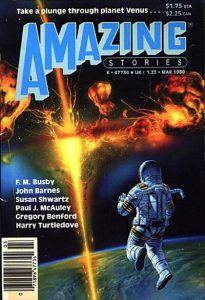 The absence of a breakthrough in circulation was a source of frustration for Price. In 1988 he discontinued full-time employment with TSR, though he continued to edit the magazine on a freelance basis. Then, toward the end of 1989, a rumor surfaced that AMAZING STORIES would cease publication when the material that Price had already purchased had been used. It was galling, to this and other long-time readers, to think that after all the work that had gone into the magazine in the 1980s to make it an exciting and challenging publication, it would now be left to die.
The absence of a breakthrough in circulation was a source of frustration for Price. In 1988 he discontinued full-time employment with TSR, though he continued to edit the magazine on a freelance basis. Then, toward the end of 1989, a rumor surfaced that AMAZING STORIES would cease publication when the material that Price had already purchased had been used. It was galling, to this and other long-time readers, to think that after all the work that had gone into the magazine in the 1980s to make it an exciting and challenging publication, it would now be left to die.
That you are reading this article (originally published in the July 1992 AMAZING STORIES) is proof that it didn’t. In the summer of 1990, TSR quashed all the rumors by announcing that the magazine would be expanded into a new slick format under a new editor, Kim Mohan.
Price stayed on, managing production of the digest-sized issues until his inventory had been exhausted with the March 1991 magazine. He, like all of his immediate predecessors, had demonstrated a strong commitment to the magazine, producing quality issues despite the hardship of scanty distribution. His issues will be among the least known, since print runs were down to a little more than 30,000, yet they contained more quality than most of the pulp issues in total.
The magazine’s incarnation in slick format under Kim Mohan is a story for another day. It’s to be judged by the historians of the 21st century. (Including Mike Ashley who tells us that he has brought his history of AMAZING STORIES up to date as part of the fourth and fifth volumes of his THE STORY OF THE SCIENCE FICTION MAGAZINES, forthcoming from Liverpool University Press.)
Instead, let us pause to consider the legacy that has come down to us over the last ninety years. Almost the whole of the science-fiction genre that exists today owes its existence to Hugo Gernsback’s launching of AMAZING STORIES in 1926. He created science fiction as a distinct marketable commodity, which other publishers then developed and promoted. Gernsback’s original desire was to create a form of fiction that put entertaining frills on a core of scientific facts and speculation that would inspire its readers to engage in experimentation and invention. Little of that kind of science fiction remains today, although I suspect that most space fiction still inspires the frontier spirit in us all, the desire to explore beyond the realms of our planet.
But the world has changed. When AMAZING STORIES was born, America had not long emerged from the horse-and-buggy days. People were still ignorant of the potential of science, and Gernsback was correct in his missionary devotion to develop an understanding of science so as to build a new and better world.
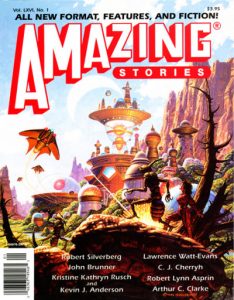 Today we live in a science-fiction world. Just about everything around us would have amazed a reader of 1926 if he were suddenly transplanted to today. That is not to say that science fiction has outgrown its usefulness; it can still inspire and stimulate, just as Gernsback originally intended.
Today we live in a science-fiction world. Just about everything around us would have amazed a reader of 1926 if he were suddenly transplanted to today. That is not to say that science fiction has outgrown its usefulness; it can still inspire and stimulate, just as Gernsback originally intended.
But let us not forget the core of his original purpose: to create a new and better world. There are many who now believe that science is killing this planet and endangering the whole of its flora and fauna. If Gernsback were alive today, he would direct his scientific zeal toward solving that problem. AMAZING STORIES is as pertinent now as it ever was. Its durability over ninety years is a lesson in itself. Its readers are probably more aware of ecological issues than many of their contemporaries. Whereas once science fiction was created to build a new world, it can now work as a force to help save it. That will be the amazing story of the twenty-first century.
“The AMAZING Story: The Eighties — Son of FANTASTIC” is © 2016 by Mike Ashley and appears here with the author’s permission. Notes in italics are by PulpFest and are © 2016 by PulpFest. The original article was published by TSR, Inc. and edited by Kim Mohan for the July 1992 issue of AMAZING STORIES. Many thanks to Curt Phillips, the moderator of the Yahoo newsgroup PulpMags, for drawing our attention to and providing us with copies of Mike Ashley’s exceptional series of articles about the world’s first science-fiction magazine. PulpFest 2016 will be celebrating the 90th anniversary of AMAZING STORIES at this summer’s convention in Columbus, Ohio from July 21st through July 24th.
(Concerning our illustrations . . . . When Arthur Bernhard purchased Sol Cohen’s share of AMAZING STORIES, he was forced to completely reboot the magazine. The new owner hired Elinor Mavor to be the magazine’s editor and art director. Aside from a vignette written by Ron Lauten, every other piece of fiction in the May 1979 AMAZING was reprinted from previous issues of the magazine. The front cover was created by Scott Mavor, Elinor’s son. A freelance illustrator, it was his sole cover for AMAZING. He also contributed thirteen interior illustrations to the magazine and its companion, FANTASTIC, all published in 1979 and 1980.
Nine months after assuming the editorship of AMAZING STORIES, Elinor Mavor was publishing all new stories, including works by Michael Kube-McDowell and Wayne Wightman, two of her discoveries. The front cover art had also significantly improved, as exemplified by David Mattingly‘s illustration for the May 1980 issue. At the time a matte artist for the Walt Disney Studios, Mattingly began contributing science fiction cover art to the book industry in 1980. He was one of the dominant science fiction paperback cover artists during the eighties, contributing over 500 covers to the industry. He painted four covers for AMAZING between 1980 and 1992.
Another artist who freelanced for Mavor was Dean Ellis. A graduate of the Cleveland Institute of Art and the Boston Museum School of Fine Art, Ellis contributed a single cover to AMAZING STORIES, the November 1980 number. A commercial and advertising artist, Ellis became involved with science fiction art when Bantam Books asked him to produce cover art for their Ray Bradbury books during the 1960s. Ellis died in 2009.
Other artists who worked for Mavor during her editorship of AMAZING STORIES included Kent Bash, Stephen Fabian, Vincent DiFate, Chris Foss, Ian Miller, and Rowena Morrill, who painted the front cover for the November 1981 issue, her sole cover for the magazine. One of the first women artists to have an impact on paperback cover illustration, Morrell has become one of the best known names in the world of science fiction and fantasy illustration. She has painted hundreds of book covers, calendars, portfolios, trading cards, and magazine covers. Her work has been used by Ace, Avon, Ballantine, Berkley, Dell, Pocket, and many other publishers.
In 1982, Arthur Bernhard sold AMAZING STORIES to TSR Hobbies, Inc., the producer of the DUNGEONS & DRAGONS® game. Hiring George Scithers to be the magazine’s editor, the company’s first issue was dated November 1982 and featured front cover art by Michael R. Whelan, one of the science fiction and fantasy industry’s leading artists. The winner of fifteen Hugo Awards, three World Fantasy Awards, and virtually every other award presented by the industry, Whelan is considered one of the world’s premier fantasy and science fiction artists.
A full-time illustrator since the mid-1950s, Jack Gaughan became closely associated with GALAXY SCIENCE FICTION, serving as the magazine’s art editor from 1969 to 1972. He painted 38 covers for GALAXY and also did 29 covers for IF, eleven covers for THE MAGAZINE OF FANTASY & SCIENCE FICTION, seven for ASIMOV’S, and many others including AMAZING STORIES for January 1984. Best known for his black-and-white interior illustrations of the 1960s, Gaughan also created many book covers for the publishing industry, most notably Ace Books.
A few years after discovering science fiction fandom, George Barr sold a pair of paintings to Cele Goldsmith. His first professional sales, they graced the covers of two 1962 issues of FANTASTIC. Unfortunately, it would be many years before he made another sale to the science fiction and fantasy industry. Most of his artwork during this period appeared in fanzines until he won the first of two Hugo Awards for Best Fan Artist in 1968. Not long thereafter, his paintings began to appear on paperbacks published by Ace, Ballantine, DAW, and other companies as well as limited editions produced by Donald A. Grant, Underwood-Miller, and others. During the last quarter of the twentieth century, Barr was particularly prolific, creating cover and interior art for books, convention programs, and magazines such as ISAAC ASIMOV’S SCIENCE FICTION MAGAZINE, MARION ZIMMER BRADLEY’S FANTASY MAGAZINE, WEIRD TALES, and AMAZING STORIES, including the number for September 1985.
During the early years of TSR’s ownership of AMAZING STORIES, Larry Elmore was creating and supervising their game-related art. He continued working for the company until 1987, when he turned to freelancing. Since then, Elmore has produced cover art for many publishers, including Ace, Baen Books, Bantam, Berkley, and Del Rey. He’s also created artwork for the comic book, gaming, motion picture, and toy industries. During his employment by TSR, Elmore created covers for DRAGON® MAGAZINE as well as a pair of covers for AMAZING, including the May 1986 issue.
George Scithers stepped down from editing AMAZING STORIES in early 1986. His position was filled by Patrick L. Price, an assistant editor for the magazine since the September 1983 issue. Price stayed on as the magazine’s editor for the next six years, employing Bob Eggleton as his cover artist for a handful of issues, including the March 1989 number. A commercial artist, Eggleton began working in the science fiction field in 1983. An extremely versatile artist, he has worked in science fiction, fantasy, horror, and as a landscape artist. His illustrations have been featured on magazines, books, posters, trading cards, jigsaw puzzles, and more. He’s also worked as a conceptual artist in the film and amusement park industries. Eggleton has won the Hugo Award for Best Artist eight times.
TSR converted AMAZING STORIES to a slick magazine beginning with the May 1991 number — the first of the Kim Mohan edited issues. It featured front cover art by the late Tim Hildebrandt, best known for the LORD OF THE RINGS calendar art that he created with his twin brother — Greg — in the 1970s. Tim and Greg also painted the original STAR WARS movie posters. After he and his brother decided to pursue separate careers, Tim went on to illustrate many calendars and paint science fiction and fantasy covers for DAW, NAL/Signet, Warner Books, STARLOG, and AMAZING STORIES. When the brothers reunited in later years, they collaborated on a wide array of trading card and comic book projects, film concept work, and much more. Tim Hildebrandt died in 2006.
TSR stopped publishing AMAZING following the Winter 1995 issue. After TSR was acquired by Wizards of the Coast, the magazine was relaunched — again with Mohan as editor. This version lasted for ten more issues, dated Summer 1998 through Summer 2000. The title was next acquired by Paizo Publishing which debuted a new monthly version — edited by Jeff Berkwits — in September 2004. This version lasted for only seven issues. Its final number — in PDF format — was dated March 2005. In July 2012, longtime science fiction fan Steve Davidson revived AMAZING STORIES as an online magazine. Two issues were released in July and August 2012. One additional issue — dated April 2014 and available in print or as an ebook — has also been released. For more information, please visit http://amazingstoriesmag.com/)

